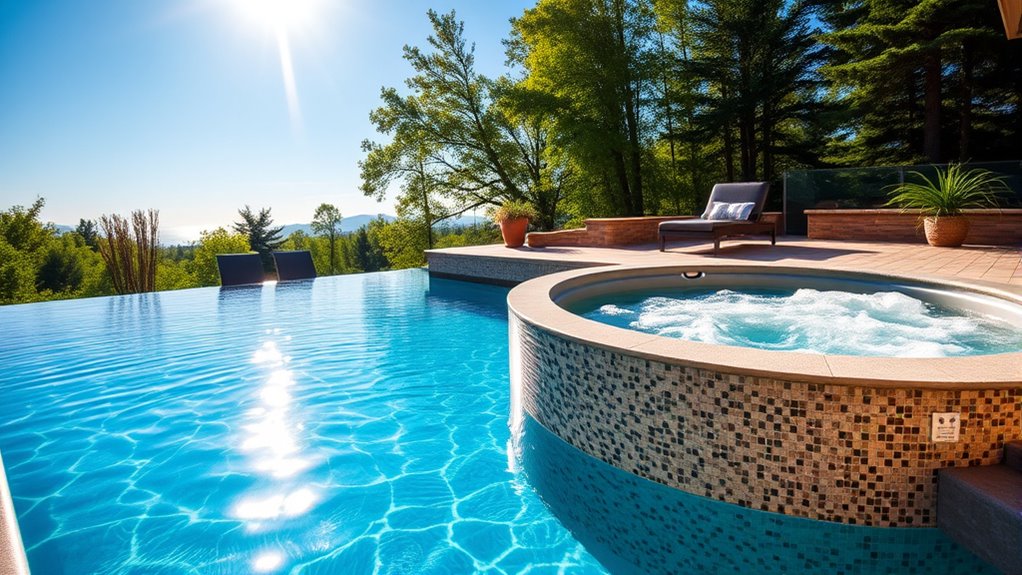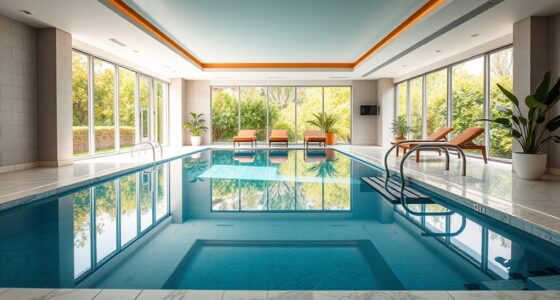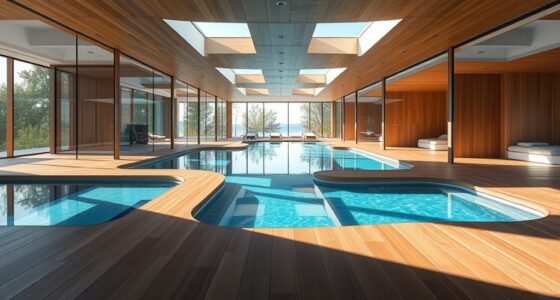Choosing between an endless pool and a swim spa depends on your space, budget, and fitness goals. An endless pool offers a compact, affordable option ideal for indoor use, while a swim spa provides a larger, more feature-rich experience suited for versatile workouts and rehabilitation. Consider installation costs, maintenance, and available space to find the right fit. If you want more details, you’ll discover helpful insights to make an informed decision.
Key Takeaways
- Endless pools are compact and suitable for indoor or outdoor use, ideal for small spaces and targeted workouts.
- Swim spas are larger, offering more space for swimming, fitness, and relaxation, suitable for outdoor installation.
- Endless pools tend to be more affordable and easier to install, while swim spas require more space and higher investment.
- Swim spas often feature advanced jets, adjustable resistance, and more customization options for versatile workouts.
- Choose based on your space, budget, desired features, and whether you prioritize simplicity or multifunctionality.
Differences in Design and Size

While both endless pools and swim spas are designed for aquatic exercise, they differ markedly in their design and size. An endless pool is typically compact, resembling a small, rectangular tub that fits easily into indoor or outdoor spaces. It usually measures around 7 to 9 feet long and 7 feet wide, with a shallow depth of about 3.5 feet. In contrast, a swim spa is larger, often stretching 12 to 16 feet in length and 7 to 8 feet wide, with depths reaching up to 4 feet or more. Its elongated shape allows for continuous swimming and more versatile workout options. The size difference impacts installation, space requirements, and overall usability, making each suitable for different preferences and environments. Self Watering Plant Pots are an example of specialized equipment designed for efficient plant care, showcasing how tailored solutions can enhance user experience.
Features and Customization Options
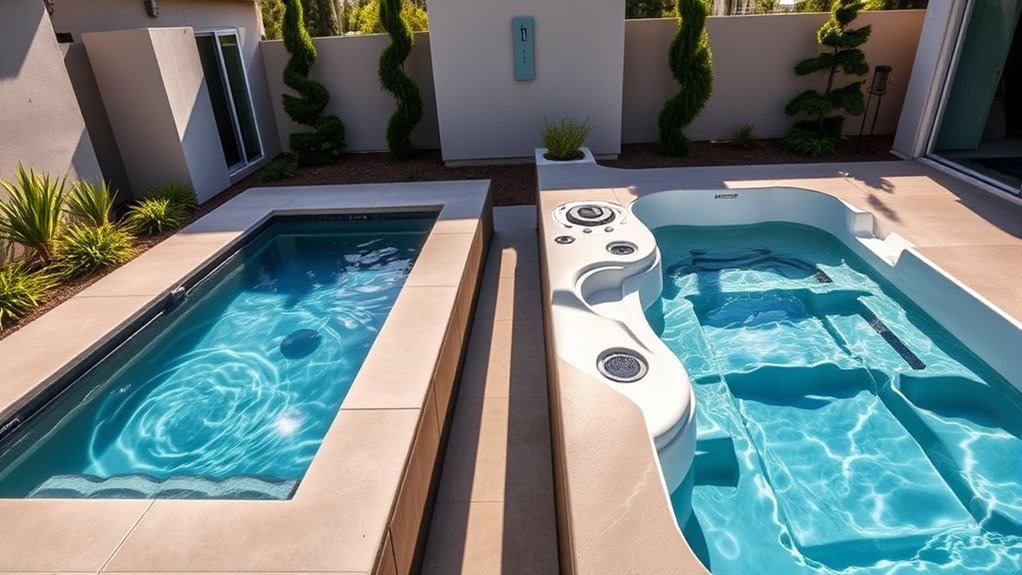
Both endless pools and swim spas offer a range of features and customization options that can enhance your aquatic workout experience. You can choose adjustable water current speeds to match your fitness level, ensuring a personalized workout every time. Many models come with advanced jets that target specific muscle groups or improve resistance, allowing you to customize your training. Additional options include integrated lighting, sound systems, and heating controls, so you can create a relaxing ambiance or extend your workout into cooler months. Some swim spas even offer built-in benches, pool covers, and water filtration systems that streamline maintenance. Overall, these features allow you to tailor your aquatic space to your preferences, making your workouts more effective and enjoyable. Incorporating ventilation considerations can also improve air quality and comfort around your pool area.
Cost and Installation Considerations
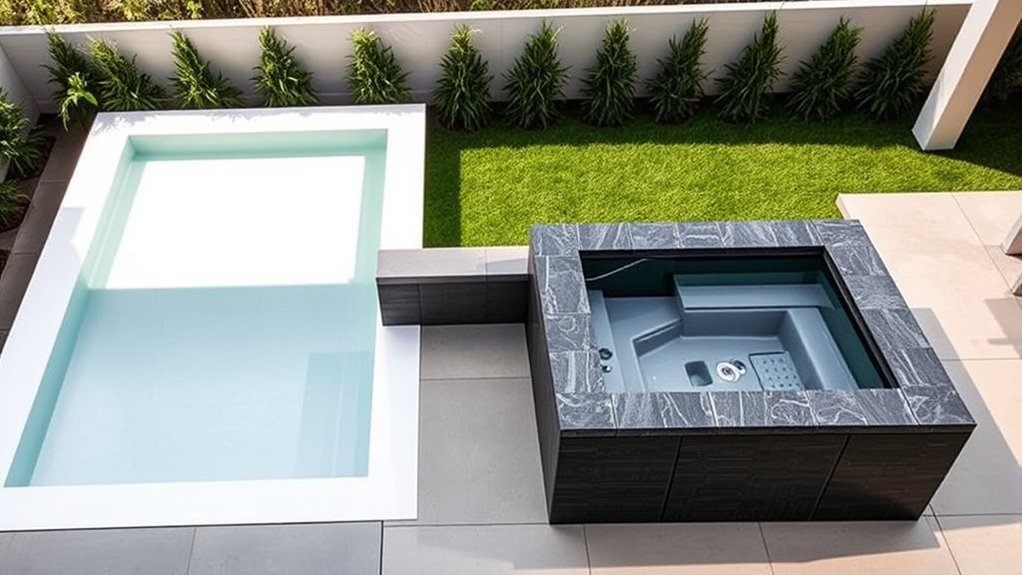
When considering the cost and installation of endless pools and swim spas, it’s important to recognize that these options vary considerably in price and setup complexity. Endless pools tend to be more affordable upfront, especially portable models that can fit into existing spaces. Swim spas, on the other hand, usually come with a higher price tag due to their larger size and advanced features. Installation can also differ; endless pools often require less extensive groundwork and can sometimes be installed indoors or outdoors with minimal modifications. Swim spas typically need a solid foundation, proper electrical wiring, and sometimes professional plumbing. Budgeting for both the purchase price and installation costs is vital to ensure you choose an option that fits your financial and space constraints. Additionally, understanding market dynamics and consumer preferences can help you make a more informed decision tailored to your needs.
Suitability for Fitness and Rehabilitation
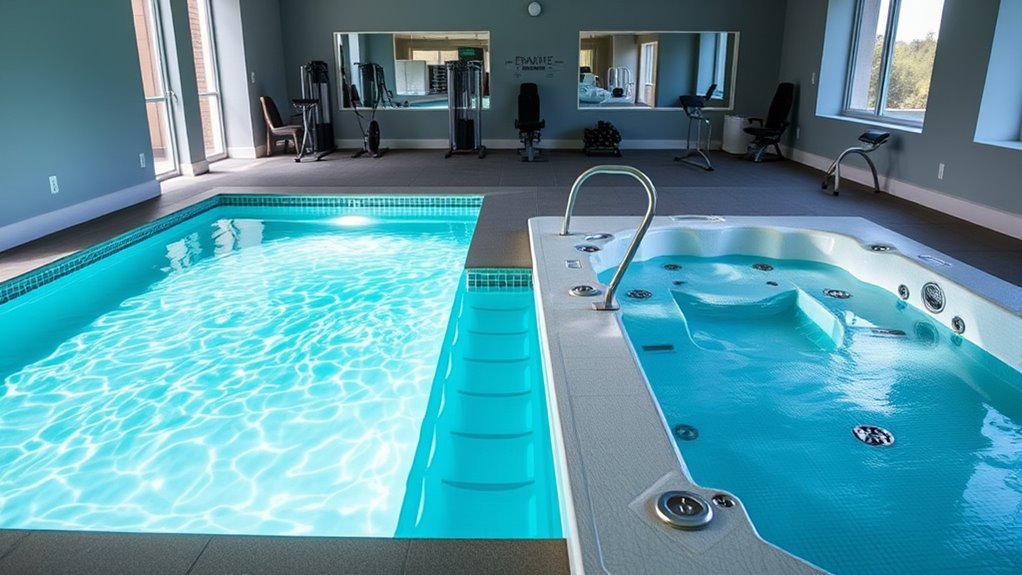
Endless pools and swim spas are designed to support fitness routines and rehabilitation needs, making them versatile additions to your health and wellness journey. Both options provide a controlled environment where you can perform low-impact exercises, ideal for improving strength, flexibility, and cardiovascular health. If you’re recovering from an injury or managing chronic conditions, these pools allow gentle, targeted movements that promote healing without putting excessive stress on your joints. Swim spas often feature adjustable water currents, enabling you to customize resistance levels for progressive training or therapeutic exercises. Whether you’re aiming to enhance athletic performance or recover from an injury, these pools offer a safe, effective space for your fitness and rehab needs, encouraging consistent activity that supports your overall well-being. Recognizing narcissistic behaviors helps in creating a supportive environment for recovery and healing.
Maintenance and Operating Expenses
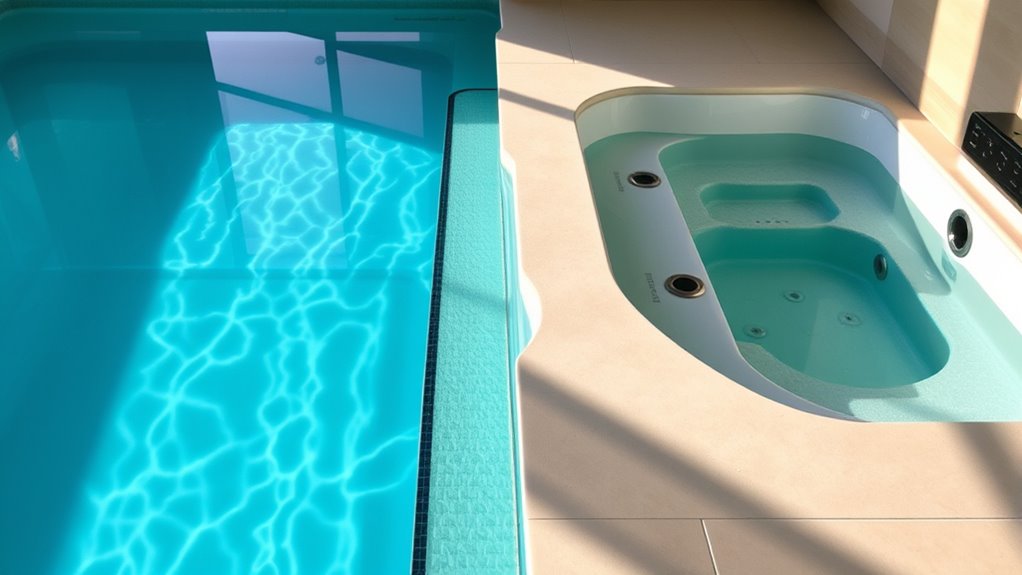
When considering maintenance and operating expenses, you’ll want to look at energy costs, routine upkeep, and long-term spending. These factors can substantially affect your budget over time. Understanding what’s involved helps you choose the option that’s more affordable to own and operate. Additionally, energy efficiency can play a significant role in reducing ongoing costs.
Energy Consumption Costs
Energy consumption costs for both endless pools and swim spas can vary considerably based on their design and usage. Generally, swim spas tend to use more energy because they’re larger and often feature more powerful jets and pumps. If you use your swim spa frequently or keep it heated year-round, your energy bills will reflect that higher consumption. Endless pools, being smaller and often designed for quick dips, typically consume less energy, especially when used intermittently. However, both options benefit from energy-efficient pumps, heaters, and insulation. To minimize costs, consider running your pool or spa during off-peak hours and keeping the temperature at a moderate level. Proper insulation and quality equipment can notably reduce ongoing energy expenses, regardless of which option you choose. Additionally, choosing energy-efficient equipment can further lower operating costs and improve overall efficiency.
Routine Maintenance Tasks
Routine maintenance is a key factor that can influence the ongoing operating expenses of both endless pools and swim spas. Keeping up with regular tasks ensures your equipment runs efficiently and extends its lifespan. You’ll need to:
- Regularly check and balance water chemistry to prevent buildup and damage
- Clean filters to maintain water clarity and pump efficiency
- Skim debris from the surface to avoid clogging filters
- Inspect jets and fittings for leaks or blockages
- Test and replace sanitizer levels as needed
Performing these tasks consistently helps avoid costly repairs and keeps your swim environment safe and inviting. Staying on top of routine maintenance also minimizes chemical waste and energy use, ultimately saving you money over time. It’s a simple way to keep your investment in top shape. Additionally, understanding projector technology can help you optimize your setup for the best viewing experience.
Long-term Operating Expenses
Long-term operating expenses for both endless pools and swim spas primarily involve ongoing maintenance and utility costs that can add up over time. You’ll need to budget for regular chemical treatments, filter replacements, and cleaning to keep the water safe and clear. Additionally, electricity bills will vary depending on the size and insulation of your unit, with swim spas generally consuming more power due to their larger size and heating requirements. Maintenance costs are predictable but essential to prevent costly repairs later. Keep in mind that neglecting routine upkeep can lead to increased expenses and shorter equipment lifespan. Proper decoding of slang and youth culture can also help you better understand and manage your pool’s maintenance needs. Overall, while initial costs might be similar, the ongoing expenses depend on usage, size, and your attention to maintenance.
Space Requirements and Placement Tips

When selecting a location for your pool, you need to take into account both space needs and practical placement tips to guarantee easy access and ideal use. First, ensure there’s enough clearance around the pool for safe entry and maintenance. Second, consider proximity to power sources and plumbing for easier installation. Third, think about privacy and how the pool placement affects your outdoor layout. Fourth, evaluate sun exposure to maximize warmth and reduce heating costs. Fifth, avoid areas prone to flooding or excessive debris. Keep in mind these tips:
- Allocate extra space for future expansion or accessories
- Position away from large trees to minimize debris
- Choose a level, stable surface for installation
- Consider wind patterns for temperature control
- Plan for easy access to lighting and safety features
- Incorporate proper drainage considerations to prevent water accumulation and damage.
Frequently Asked Questions
Can Both Pools Be Used Year-Round Indoors?
Yes, you can use both pools indoors year-round. Indoor setups provide a controlled environment, so temperature and humidity are easier to manage, allowing you to swim comfortably regardless of the season. Make sure your space has proper ventilation and insulation to prevent moisture build-up and damage. With the right maintenance, both an endless pool and a swim spa can serve as your personal aquatic oasis all year long.
Which Pool Type Offers Better Energy Efficiency?
You’ll find that swim spas generally offer better energy efficiency because they’re designed with insulated shells and efficient heating systems, reducing running costs. Endless pools, while convenient, often use more energy due to smaller size and less insulation. If saving on energy bills matters to you, a swim spa’s larger size and advanced features make it a smarter, more eco-friendly choice, especially if used year-round indoors.
Are There Specific Safety Features for Children?
Yes, both pools often come with safety features for children. You might find childproof covers, lockable lids, or safety fencing to prevent accidental falls. Some models also include non-slip surfaces and alarms that alert you if the pool is accessed unexpectedly. Always check the specific features of the pool you choose to guarantee it meets safety standards for children and provides peace of mind during family use.
How Long Does Installation Typically Take?
Installation generally takes between one to three days, depending on the model, site preparation, and whether you’re installing indoors or outdoors. You’ll want to make certain the area is ready, with proper electrical and plumbing connections. If you opt for professional installation, they’ll handle most of the work quickly and efficiently. Planning ahead and coordinating with installers helps avoid delays, so you can enjoy your new pool sooner.
Which Pool Type Is More Eco-Friendly?
You’ll find that swim spas tend to be more eco-friendly because they usually have energy-efficient heating and filtration systems, and their larger size allows for better insulation, reducing energy use. Endless Pools, while compact and convenient, may consume more energy per use due to their smaller size and sometimes less efficient heating. To maximize eco-friendliness, choose models with energy-saving features and guarantee proper insulation regardless of which type you select.
Conclusion
Choosing between an endless pool and a swim spa depends on your fitness goals and space. Did you know that swim spas can cost up to 50% more than endless pools? But with their added features, they might be worth it. Consider your budget, available space, and intended use to make the best choice. Whichever you pick, investing in your health and wellness is always a smart move. Plunge in and enjoy your perfect aquatic retreat!

